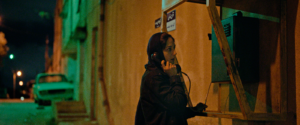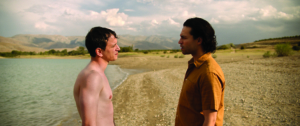It sounds like an outlandish premise for a film: in rural Rajasthan, India, a new religion arises in which followers worship a vintage motorcycle. Yet, the most outlandish thing about this set-up – which forms the narrative outline of Ritwik Pareek’s feature debut, Dug Dug (2021) – is that it is actually true. In May 1988, a motorcyclist crashed near Jodhpur, and legend soon grew that the bike, even when impounded by police, would mysteriously return to the crash site. Ever since, devotees have stopped there to pray to an old 350cc Royal Enfield for safe journeys.[1]See Apurva, ‘A Prayer for Drunk Rider, Shrine for His Bike’, The Indian Express, 25 October 2009, <https://indianexpress.com/article/news-archive/web/a-prayer-for-drunk-rider-shrine-for-his-bike/>, accessed 21 April 2022. ‘Though the premise is very absurd, it’s all real,’ says Pareek. ‘It’s a real temple where they pray to a Bullet bike […] They actually offer alcohol to it. It’s a small shrine in a remote village, but people have created this huge faith around this temple.’[2]Ritwik Pareek, interview with author, 6 October 2021.
Though the film is couched in reality, Pareek’s goal with Dug Dug – whose name is an onomatopoeic colloquialism for a certain kind of puttering motorcycle – was to take the tale and ‘escalate it to a level that’s madly bonkers’. The director was inspired by absurdist satires like Dr. Strangelove or: How I Learned to Stop Worrying and Love the Bomb (Stanley Kubrick, 1964), Monty Python and the Holy Grail (Terry Gilliam & Terry Jones, 1975) and Monty Python’s Life of Brian (Jones, 1979), as well as being informed by evolutionary biologist Richard Dawkins’ critical writings on religion and faith.[3]Specifically, Dawkins’ 2006 book The God Delusion. See Faizal Khan, ‘Dug Dug: A Film Inspired by India’s Motorcycle God’, BBC News, 8 November 2021, <https://www.bbc.com/news/world-asia-india-59036542>, accessed 21 April 2022. The result is a wildly colourful movie that, once hitting its stride, rollicks along with a sense of giddy joy, propelled by a ‘groovy’ score from Mumbai’s Salvage Audio Collective.
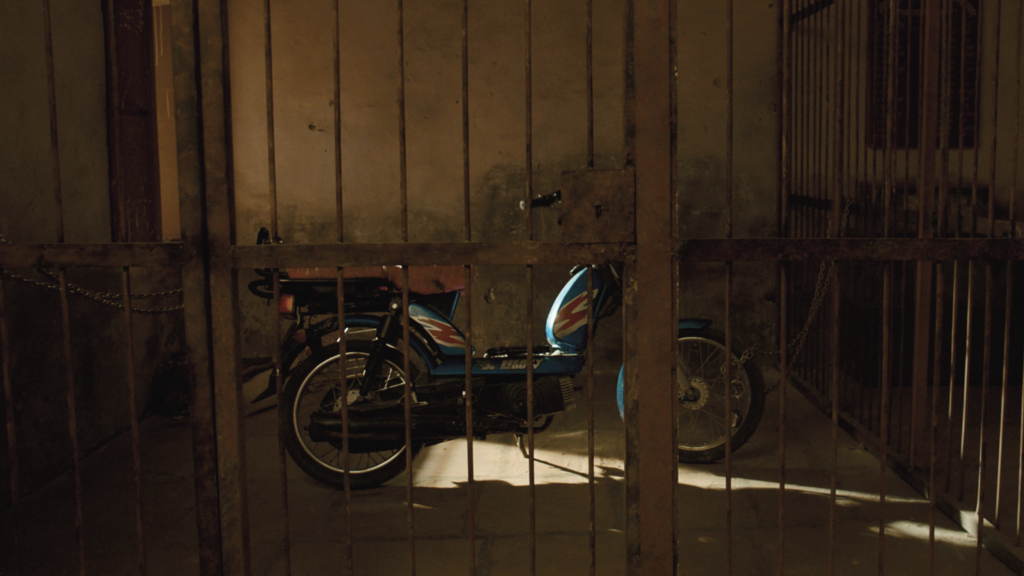
The rhythm of the movie both conveys its themes and drives its viewing experience. With no real central characters and little in the way of traditional narrative – ‘The main character,’ Pareek says, ‘should be the motorbike’ – Dug Dug both depicts and embodies the growth of a new religion, effectively turning the spread of an idea or belief into a sense of on-screen momentum. It does so by, after an often slow and ponderous opening act, transforming into a sustained thirty-minute montage in which the religion takes on a life of its own – this rapid growth, and the commodification and commercialisation of faith, conveyed via bright images, breathless editing and relentless rhythm. ‘Once the seed takes hold, and takes on a life of its own,’ Pareek says, ‘it just grows and grows and grows, and you can’t stop it.’
Though the film’s sense of energy and foregrounding of music evoke Bollywood cinema, Pareek’s references and influences are distinctly Western: his use of rapid editing, creative transitions, zany whip pans and smash zooms draws from the work of Sam Raimi and Edgar Wright; while his ‘comical framing’ is informed by the distinctive aesthetics of Taika Waititi and Wes Anderson.[4]Anderson is enough of a cinematic forefather that Pareek named his production house Bottle Rocket, inspired by the DIY, friends-and-family beginnings that led to Anderson’s 1996 debut feature of the same name being made. But Dug Dug’s influences extend beyond the cinematic, its wild visuals often deliberately playing with the conventions of television and advertising.
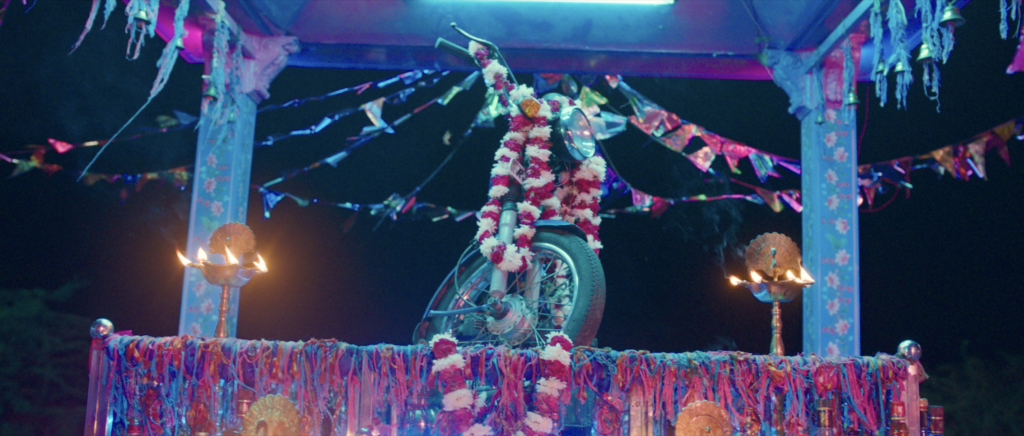
Pareek came to directing from a design background, having gotten his bachelor’s degree in the field before working at an advertising agency as art director. Growing up, he was obsessed with visual art and painting, but as an adult became an ardent cinephile, eventually quitting his ad gig to pursue filmmaking. Founding his own production company and funding the film through personal savings and loans from his parents and relatives, he spent three years making Dug Dug. The film was a wholly independent production, with Pareek writing and directing the film as well as driving all over Rajasthan as location scout. Only two members of Dug Dug’s vast cast are theatre actors; the rest, non-professionals found through mass auditions. The intention was always for the film to play on big screens, but much of the production – including the entire edit and score composition – had to occur remotely during COVID restrictions. Eventually, this small film made it to the biggest of screens: Dug Dug’s 2021 Toronto International Film Festival premiere took place in an IMAX cinema. ‘We designed the entire film keeping the theatre screen in mind,’ Pareek says. ‘If you watch it on a laptop, you might miss out on certain things, because the art design is too detailed; there is so much information in every shot.’
Dug Dug opens with a drunken Thakur Sa (Altaf Khan) stumbling out of a bar, a solitary figure set against blue and pink neon lights (echoing the colour palette used vividly throughout). As he slips into the darkness and onto his motorbike, he heads out on the highway, where he is seen from on high. (This perspective evokes the director’s belief that, in order to understand religious fervour, he needed to ‘look at it from a little bit further away, like from a God’s-eye view’.) Thakur wibbles and wobbles dangerously, eventually wiping out underneath a billboard depicting a shadowy magician with two buxom assistants – this mystical, sorcerous figure looming over the spectral mysteries to come. In an impressive single take, the camera looks down on the sprawled-out form of the still-alive rider from above, descends to a kneeling position, then cranes upwards to come face to face with the billboard magician. We hear the sound of the driver being squished by a passing truck, then return to find time passed and the scene now one of chaos. As ambulances, police and teeming masses gather, the blue and red flashing lights of the emergency vehicles herald the blue-and-pink colour scheme to come.
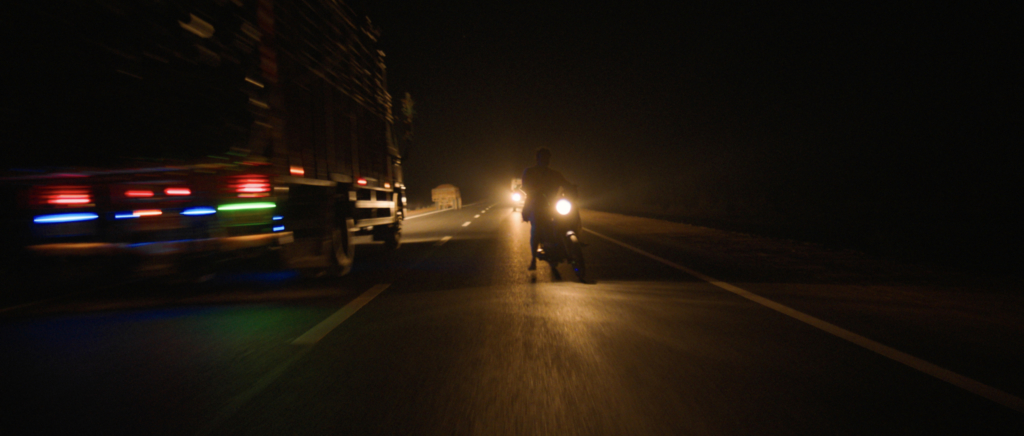
Save for the drunken ramblings of bumbling rural police sitting around and shooting the breeze (‘God only knows what games he plays,’ one says, tellingly; ‘everything is his will’), most of the early going plays out without dialogue. The bike is impounded by police, only to escape and magically return to the scene overnight. The police haul it back to the station, funnel out all its petrol and shackle it in chains, but the next morning the ‘dug dug’ is found once more at the site of the crash. The next night, it escapes from a jail cell, at which point the police give up trying to restrain the bike and give into its nascent fame, posing for selfies and newspaper photographs alongside it in front of both the jail cell and the billboard.
Dug Dug then moves briefly into a conversation piece, in which local politicians, religious leaders and citizens discuss the meaning of this inexplicable phenomenon. Crowds begin to gather at the site, curious onlookers mixing with fervent proponents of a miracle. When a priest (Jagdish Prasad Tak) is sought to give his blessing to the erection of a shrine at the crash site, he essentially shrugs. ‘Everyone is seeking God’s blessings, but God still isn’t listening. Why isn’t he listening?’ he asks. ‘He is bored and tired; that’s why.’ If God won’t listen to us directly, the priest reasons, Thakur Sa may be his messenger. So, the priest suggests, set up a shrine, and bring Thakur’s favourite thing – alcohol – as an offering. As followers start chanting thanks and praise to their new god, Pareek cuts to a shot of sheep being herded along a rural pathway, evoking religion in both positive fashion (Lord as shepherd) and negative (devotees as sheep).
From there, it’s montage mania: we see alcohol poured onto the motorcycle’s front tyre, its handlebars draped in floral wreaths. Blue and pink – the respective colours of the motorcycle and its seat – become the colours of the Thakur Sa religion, soon seen in ribbons, turbans, flags, paint and merchandising. A slew of businesses – ranging from construction to butchery, hairdressers to electronic goods – rebrand themselves under Thakur Sa’s name. A news report momentarily stills the rush of montage, but only signals an acceleration in the growth of the new faith, word spreading far and wide. We smash-cut from a wealthy man reading a newspaper story on the phenomenon to a shot of him bearing an oversized novelty cheque at the launch of the Thakur Sa Charitable Trust. Donations begin with notes laid at the wheels of the motorcycle before moving on up to envelopes, moneyboxes, EFTPOS terminals and remote phone payments via an app. Overhead shots of money pile up like sequences from a Mafia movie. The Thakur Sa Motor Company sells pink-and-blue tractors. Construction begins on the Thakur Sa Higher Secondary School, Hospital and University; eventually, the shrine is replaced by a colossal marble temple, a tourist trap funnelling pilgrims in and out. Celebrations extend to night-time ‘holy marches’, fluoro raves in which DJ Gujar (played by musician Ankur Tewari) lets loose autotuned commandments over thumping EDM beats. ‘Raise your hands and get drunk on Thakur Sa’s worship,’ he warbles, the pace and pitch escalating until the music reaches a furious climax, the film hitting a wild sensorial peak.
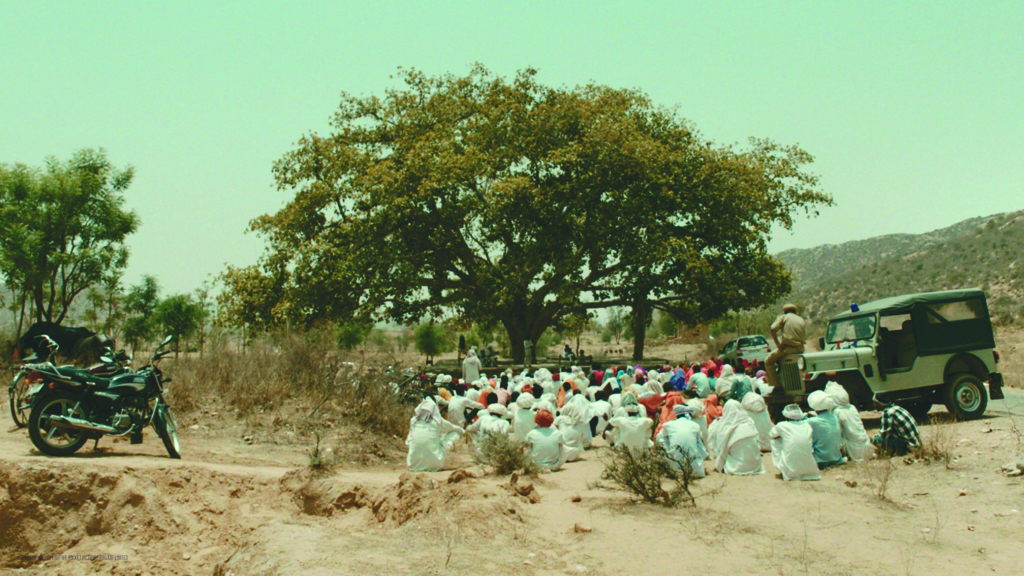
This act-long undertaking of ‘constant montage’, Pareek says, was his way of trying to convey a broad concept in a short amount of time: Dug Dug depicts how a religion is born, takes hold and grows, from word of mouth through to concerted commercialisation – faith, as always, being squeezed for profit. Mass media and the internet are indivisible from this spread; the film effectively echoes virality, and its downfalls, in the extremely-online age. ‘No matter how the idea is spreading,’ the director offers, ‘people like to connect thoughts, to try and make sense of things they don’t understand.’ Modern-day religion – not to mention the COVID-19 infodemic and its attendant conspiracy theories[5]See Steven Aoun, ‘Pandemic Paradox: Navigating Technology in the Time of COVID-19’, Metro, no. 206, 2020, pp. 100–5. – is, he suggests, an attempt to answer the same questions that naked apes have been puzzling over ever since achieving self-awareness.
Most films about modern religion are about cults, in which a singular opportunist sits at the centre of a burgeoning movement. These films don’t depict faith, but rather plays for money and power, their central singular individuals personifying – and pandering to – the celebration of the self (see, for example, Paul Thomas Anderson’s towering 2012 masterpiece The Master). But, with a dead Messianic figure at its movement’s heart, Dug Dug has a different feeling: it’s less about the founding of a new religion than about its spread. While it’s obviously a critique – and duly ridiculous at times – it’s a movie that never mocks faith itself. ‘Most religions start out with good intentions,’ Pareek observes. Approaching faith, he says, his core idea was ‘don’t try to understand it; just go with the flow’; thus the giddy momentum of the film’s montages, which show that ‘everyone is on that ride’.
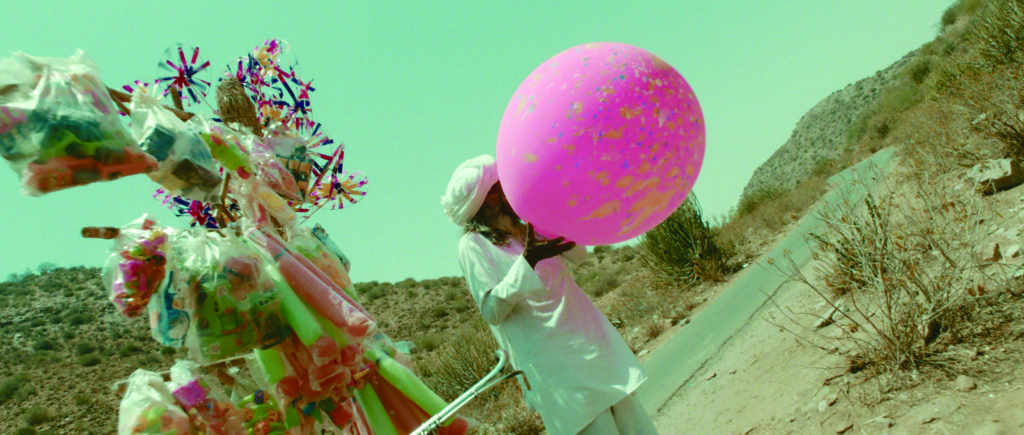
By the film’s end, the one character who’s remained defiantly, dismissively sceptical of the movement, local policeman Pyare (Gaurav Soni), finally relents. Staring at the devotional paintings inside the temple – in which Thakur Sa rides his motorcycle towards the heavens, escaping the devils of the earthly plane – he finally acknowledges something bigger than himself. His wife (Priyanka Khandekar) is sure that her offerings to the rider are what have finally blessed the couple with something that medical professionals could never give them, a firstborn son; and so Pyare holds his infant up into the glowing lights of the dug dug’s headlamp, giving thanks and praise to Thakur Sa.
For viewers conditioned to seeing movies depicting the familiar rise and fall of film narratives – wherein every montage of stacked money is followed by one of drug-fuelled downward spiral – the escalating trajectory of Dug Dug conveys a distinctive, unexpected experience. There’s a single recurring image used to communicate this phenomenon, appearing at the start of the grand montage and culminating in the film’s final shot. At the birth of the movement, an old man on the road outside the shrine starts blowing up a pink balloon, which swells in size each time we return to it; we suspect that the moment will come when, like tulipomania[6]See Dan Piepenbring, ‘Tulipomania!’, The Paris Review, 3 February 2014, <https://www.theparisreview.org/blog/2014/02/03/tulipomania/>, accessed 23 May 2022. or subprime mortgage lending[7]See Jenny Anderson & Heather Timmons, ‘Why a U.S. Subprime Mortgage Crisis Is Felt Around the World’, The New York Times, 31 August 2007, <https://www.nytimes.com/2007/08/31/business/worldbusiness/31derivatives.html>, accessed 23 May 2022. before it, the Thakur Sa bubble bursts. But, in Dug Dug’s final shot, the comically large balloon is still being inflated, still growing, until it takes up the whole of the screen. This may be interpreted as a critique of religion, but Pareek is also acknowledging that faith is bigger than any film, unable to be contained within a frame.
Endnotes
| 1 | See Apurva, ‘A Prayer for Drunk Rider, Shrine for His Bike’, The Indian Express, 25 October 2009, <https://indianexpress.com/article/news-archive/web/a-prayer-for-drunk-rider-shrine-for-his-bike/>, accessed 21 April 2022. |
|---|---|
| 2 | Ritwik Pareek, interview with author, 6 October 2021. |
| 3 | Specifically, Dawkins’ 2006 book The God Delusion. See Faizal Khan, ‘Dug Dug: A Film Inspired by India’s Motorcycle God’, BBC News, 8 November 2021, <https://www.bbc.com/news/world-asia-india-59036542>, accessed 21 April 2022. |
| 4 | Anderson is enough of a cinematic forefather that Pareek named his production house Bottle Rocket, inspired by the DIY, friends-and-family beginnings that led to Anderson’s 1996 debut feature of the same name being made. |
| 5 | See Steven Aoun, ‘Pandemic Paradox: Navigating Technology in the Time of COVID-19’, Metro, no. 206, 2020, pp. 100–5. |
| 6 | See Dan Piepenbring, ‘Tulipomania!’, The Paris Review, 3 February 2014, <https://www.theparisreview.org/blog/2014/02/03/tulipomania/>, accessed 23 May 2022. |
| 7 | See Jenny Anderson & Heather Timmons, ‘Why a U.S. Subprime Mortgage Crisis Is Felt Around the World’, The New York Times, 31 August 2007, <https://www.nytimes.com/2007/08/31/business/worldbusiness/31derivatives.html>, accessed 23 May 2022. |

